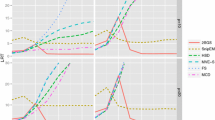Summary
In this paper, two types of robust estimators and approximate confidence intervals for the difference of location parameters of correlated random variables are proposed and investigated when some observations are missing. It is shown that the suggested estimators are consistent and asymptotically normally distributed. In addition, the proposed approximate confidence intervals are also shown to enjoy some nice asymptotic properties.
Similar content being viewed by others
References
Anderson, T. W. (1957). Maximum likelihood estimates for multivariate normal distribution when some observations are missing,J. Amer. Statist. Ass.,52, 200–214.
Boos, D. (1980). A new method for constructing approximate confidence intervals,J. Amer. Statist. Ass.,75, 142–145.
Boos, D. and Serfling, R. J. (1980). A note on differentials and CLT and LIL for statistical functions with application toM-estimates,Ann. Statis.,8, 618–624.
Geertsema, J. C. (1970). Sequential confidence intervals based on rank tests,Ann. Math. Statist.,41, 1016–1026.
Gupta, A. K. and Rohatgi, V. K. (1978). Inference on the difference of means of correlated variables from fragmentary samples,Sankhyã, B40, 49–64.
Hampel, F. R. (1968).Contributions to the Theory of Robust Estimation, Ph.D. dissertation University of California, Berkeley.
Hampel, F. R. (1974). The influence curve and its roles in robust estimation,J. Amer. Statist. Ass.,69, 383–397.
Hoeffding, W. (1963). Probability inequalities for sums of bounded random variables,J. Amer. Statist. Ass.,58, 13–30.
Huber, P. J. (1964). Robust estimation of a location parameter,Ann. Math. Statist.,35, 73–101.
Lin, P. E. (1971). Estimation procedures for difference of means with missing data,J. Amer. Statist. Ass.,66, 634–636.
Lin, P. E. (1973). Procedures for testing the difference of means with incomplete data,J. Amer. Statist. Ass.,68, 699–703.
Lin, P. E. and Stivers, L. E. (1974). On difference of means with incomplete data,Biometrika,61, 325–334.
Mehta, J. S. and Gurland, J. (1969). Some properties and an application of a statistic arising in testing correlation,Ann. Math. Statist.,40, 1736–1745.
Serfling, R. J. (1980).Approximation Theorems of Mathematical Statistics, Wiley, New York.
Wei, L. J. (1981). Estimation of location difference for fragmentary samples,Biometrika,68, 471–476.
Wilks, S. S. (1932). Moments and distributions of estimates of population parameters from fragmentary samples,Ann. Math. Statist.,3, 163–203.
Author information
Authors and Affiliations
About this article
Cite this article
Cheng, K.F. Nonparametric inference on the difference of location parameters of correlated variables from fragmentary samples. Ann Inst Stat Math 39, 331–347 (1987). https://doi.org/10.1007/BF02491472
Received:
Revised:
Published:
Issue Date:
DOI: https://doi.org/10.1007/BF02491472




